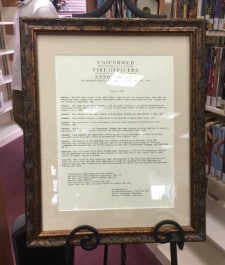A Civil Rights Resolution Rediscovered
Birmingham’s Smithfield Library is usually quiet. But on this day in February, there’s a light chatter among the high school students, city leaders and civil rights activists gathered here. Gwendolyn Sanders-Gamble stands in front of them at a podium and talks about her memories participating in the children’s marches. In May 1963, black youth marched to protest segregation in Birmingham. They were met with police attack dogs and water cannons.
“The water from those fire hoses, the water that was so painful and so forceful that it pinned me against the wall,” Sanders-Gamble said.
Pictures from the marches shocked many around the country and helped spur President John F. Kennedy to call for the Civil Rights Act.
Near Sanders-Gamble is a gold frame on an easel. It’s a copy of a resolution sent to Birmingham in July 1963 from the Uniformed Fire Officers Association of New York City – a firefighters union. It condemns the use of fire hoses to harm rather than protect innocent children. This unveiling at the Smithfield Library is also the first time the resolution been publicly shared in Birmingham.
But five decades ago in New York, the resolution generated controversy.
Making a Statement
The union’s all-white executive board wrote the resolution. It was something retired fire captain Vincent W. Julius and other black firefighters were happy to see. He says the violence in Birmingham bothered him tremendously.
“I’ve used that same hose to knock down brick walls and here you were hitting children with it,” said Julius. “It still brings tears to my eyes when I think about it.”
But when the board presented the resolution to the general membership, they tabled it. Even though Julius was black and relatively new to the union, he protested in front of the board. The panel overruled the membership and passed the resolution unanimously.
“I’ m very proud of that,” said Julius. “It was a good move, a tough move. I took some brick bats for it, but who the hell cares? Life is made to take adversaries.”
The union sent it to Birmingham and nothing else really happened.
Rediscovery
In 2013, several retired black New York firemen mentioned the story of the resolution to the union president at the time. He had never heard of it. So he looked for and found the document in the archives.
“It intrigued all the board members because not only is this prominent piece of history for the fire officers association, this is a prominent piece of history for our country and the civil rights movement,” said Jake Lemonda, current president of the Uniformed Fire Officers Association.
The union held a press conference last year to thank the New York firefighters from fifty years ago and to draw attention to the resolution. They alsowanted to recognize Birmingham foot soldiers and were put in touch with Janice Kelsey and Gwendolyn Sanders-Gamble. The two knew the union invited them to New York because of their connection to the children’s marches. But Sanders-Gamble says they didn’t know about the resolution itself until the press event.
“We knew nothing that we had the support of New York’s fire department or any other fire department, for simple fact that Eugene Bull Conner led everyone to believe that everyone in the world agreed with what he was doing,” said Sanders-Gamble.
Birmingham Battalion Chief C.W. Mardis didn’t know about it either.
“[Reading the resolution] was a surreal experience,” said Mardis. “It was almost like finding a time capsule.”
He says it’s also a comfort to see firefighters were speaking out against the tactics in Birmingham.
The resolution is on permanent display at Smithfield Library.
Memory loss: As AI gobbles up chips, prices for devices may rise
Demand for memory chips currently exceeds supply and there's very little chance of that changing any time soon. More chips for AI means less available for other products such as computers and phones and that could drive up those prices too.
Brigitte Bardot, sex goddess of cinema, has died
Legendary screen siren and animal rights activist Brigitte Bardot has died at age 91. The alluring former model starred in numerous movies, often playing the highly sexualized love interest.
For Ukrainians, a nuclear missile museum is a bitter reminder of what the country gave up
The Museum of Strategic Missile Forces tells the story of how Ukraine dismantled its nuclear weapons arsenal after independence in 1991. Today many Ukrainians believe that decision to give up nukes was a mistake.
Jeffrey R. Holland, next in line to lead Church of Jesus Christ of Latter-day Saints, dies at 85
Jeffrey R. Holland led the Quorum of the Twelve Apostles, a key governing body. He was next in line to become the church's president.
Winter storm brings heavy snow and ice to busy holiday travel weekend
A powerful winter storm is impacting parts of the U.S. with major snowfall, ice, and below zero wind chills. The conditions are disrupting holiday travel and could last through next week.
Disability rights advocate Bob Kafka dead at 79
Bob Kafka was an organizer with ADAPT (American Disabled for Attendant Programs Today), a group which advocates for policy change to support people with disabilities.









